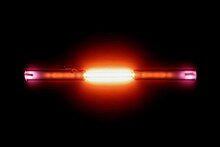ຮີລຽມ
ຮີລຽມ (Helium; ຈາກ ພາສາກະເລັກ: ἥλιος helios) ເປັນ ອົງປະກອບທາງເຄມີ; ມັນມີ ສັນຍາລັກ He ແລະ ເລກປະລໍາມະນູ 2. ມັນເປັນ ອາຍແກັສ ທີ່ບໍ່ມີສີ, ບໍ່ມີກິ່ນ, ບໍ່ມີສານພິດ, inert, ອາຍແກັສ monatomic ແລະທໍາອິດໃນກຸ່ມ ອາຍແກັສ noble ໃນ ຕາຕະລາງໄລຍະເວລາ.[lower-alpha 1] ຈຸດຮ້ອນ ຂອງຕົນແມ່ນຕ່ໍາສຸດໃນບັນດາ ອົງປະກອບ ທັງຫມົດ, ແລະມັນບໍ່ມີ ຈຸດລະລາຍ ໃນຄວາມກົດດັນມາດຕະຖານ. ມັນເປັນ ອົງປະກອບທີ່ອ່ອນໂຍນທີ່ສຸດແລະອຸດົມສົມບູນ ທີ່ສອງໃນ ຈັກກະວານ ສັງເກດໄດ້, ຫຼັງຈາກ ໄຮໂດຣເຈນ. ມັນມີຢູ່ໃນປະມານ 24% ຂອງມະຫາຊົນອົງປະກອບທັງຫມົດ, ເຊິ່ງຫຼາຍກ່ວາ 12 ເທົ່າຂອງມະຫາຊົນຂອງອົງປະກອບທີ່ຫນັກທັງຫມົດລວມກັນ. ຄວາມອຸດົມສົມບູນຂອງມັນແມ່ນຄ້າຍຄືກັນກັບນີ້ຢູ່ໃນທັງ ດວງອາທິດ ແລະ ດາວພະຫັດ, ເນື່ອງຈາກວ່າ ພະລັງງານການຜູກມັດ nuclear ສູງຫຼາຍ (ຕໍ່ ນິວຄລີອອນ) ຂອງ helium-4, ກ່ຽວກັບສາມອົງປະກອບຕໍ່ໄປຫຼັງຈາກ helium. ພະລັງງານຜູກມັດ helium-4 ນີ້ຍັງກວມເອົາວ່າເປັນຫຍັງມັນເປັນຜະລິດຕະພັນຂອງທັງສອງ ນິວເຄລຍ fusion ແລະ ການທໍາລາຍ radioactive. ໄອໂຊໂທບທົ່ວໄປທີ່ສຸດຂອງ helium ໃນຈັກກະວານແມ່ນ helium-4, ສ່ວນໃຫຍ່ໄດ້ຖືກສ້າງຕັ້ງຂຶ້ນໃນລະຫວ່າງ ສຽງປັ້ງໃຫຍ່. ຈໍານວນຂະຫນາດໃຫຍ່ຂອງ helium ໃຫມ່ແມ່ນສ້າງຂຶ້ນໂດຍນິວເຄລຍ fusion ຂອງ hydrogen ໃນ ດາວ.

ເອກະສານອ້າງອີງ
- ↑ Grochala, Wojciech (1 November 2017). "On the position of helium and neon in the Periodic Table of Elements". Foundations of Chemistry. 20 (2018): 191–207. doi:10.1007/s10698-017-9302-7.
- ↑ Bent Weberg, Libby (18 January 2019). ""The" periodic table". Chemical & Engineering News. 97 (3). Retrieved 27 March 2020.
- ↑ Grandinetti, Felice (23 April 2013). "Neon behind the signs". Nature Chemistry. 5 (2013): 438. Bibcode:2013NatCh...5..438G. doi:10.1038/nchem.1631. PMID 23609097.
- ↑ Kurushkin, Mikhail (2020). "Helium's placement in the Periodic Table from a crystal structure viewpoint". IUCrJ. 7 (4): 577–578. Bibcode:2020IUCrJ...7..577K. doi:10.1107/S2052252520007769. PMC 7340260. PMID 32695406. Retrieved 19 June 2020.
- ↑ Labarca, Martín; Srivaths, Akash (2016). "On the Placement of Hydrogen and Helium in the Periodic System: A New Approach". Bulgarian Journal of Science Education. 25 (4): 514–530. Archived from the original on 29 November 2021. Retrieved 19 June 2020.
- ↑ Siekierski, S.; Burgess, J. (2002). Concise Chemistry of the Elements. Horwood. pp. 23–26. ISBN 978-1-898563-71-6.
- ↑ Lewars, Errol G. (5 ທັນວາ 2008). Modeling Marvels: Computational Anticipation of Novel Molecules. Springer Science & Business Media. pp. 69–71. ISBN 978-1-4020-6973-4. Archived from the original on 19 ພຶດສະພາ 2016.
Preview of references
- ↑ A few authors dispute the placement of helium in the noble gas column, preferring to place it above beryllium with the alkaline earth metals. They do so on the grounds of helium's 1s2 electron configuration, which is analogous to the ns2 valence configurations of the alkaline earth metals, and furthermore point to some specific trends that are more regular if helium is placed in group 2.[1][2][3][4][5] These tend to relate to kainosymmetry and the first-row anomaly: the first orbital of any type is unusually small, since unlike its higher analogues, it does not experience interelectronic repulsion from a smaller orbital of the same type. Because of this trend in the sizes of orbitals, a large difference in atomic radii between the first and second members of each main group is seen in groups 1 and 13–17: it exists between neon and argon, and between helium and beryllium, but not between helium and neon. This similarly affects the noble gases' boiling points and solubilities in water, where helium is too close to neon, and the large difference characteristic between the first two elements of a group appears only between neon and argon. Moving helium to group 2 makes this trend consistent in groups 2 and 18 as well, by making helium the first group 2 element and neon the first group 18 element: both exhibit the characteristic properties of a kainosymmetric first element of a group.[6] However, the classification of helium with the other noble gases remains near-universal, as its extraordinary inertness is extremely close to that of the other light noble gases neon and argon.[7]